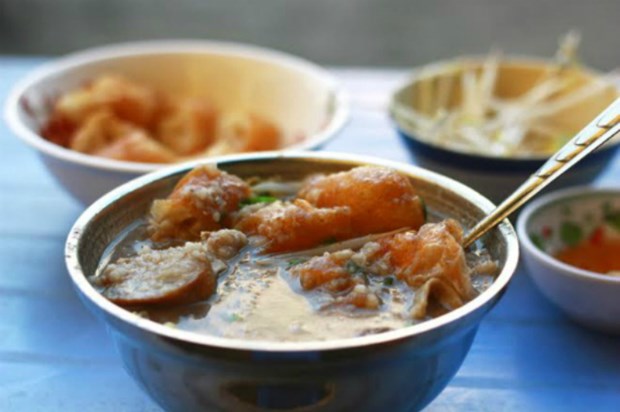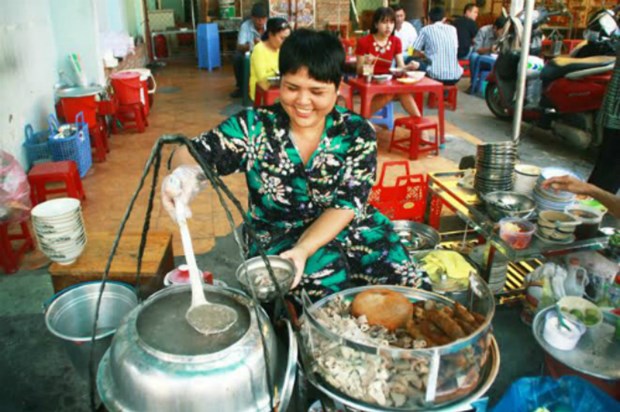The
rainy season has arrived early in Saigon, so it's probably time to start
planning that special date.
I’m
not talking about a romantic night in a cozy café with a piano, but this one
could be just as good if you don't mind the sound of pork intestines being
munched upon.
Chao
long, which literally means intestine porridge, is cooked in a brown broth made
from braising a pig's bones, head and innards.
It
is served with pieces of tongue, heart, liver, chitterlings and cooked blood
pudding. The highlight is the doi,
which looks like a Western sausage, but is filled with a mixture of cooked
blood pudding, mung beans and herbs. Some shops also serve fried doi and chitterlings.
A
perfect bowl is topped with chopped onions, ground pepper and extra herbs.

Chao long served at a restaurant on Co Giang Street in downtown Saigon. Photo by VnExpress/Duc Thanh
The
porridge serves as a typical Vietnamese dish because it stays true to the
country’s culinary tradition of wasting next to nothing.
It
also confirms the Vietnamese culinary philosophy of combining the senses. It is
a dish that brings out the best taste, smell, look and the sound made from
slurping the porridge and crunching through the tough innards, and even the
tactile aspect if one wants to eat with bare hands.
Late
author and journalist Vu Bang wrote in his 1960 book, Mieng ngon Ha Noi (Hanoi
Delicacies), that chao long is
something uniquely Vietnamese, since westerners do not know how to eat pig’s
innards while a Chinese only eats innards stuffed in a baguette or with rice
wine.
“Eating
like that cannot be tasty at all,” he wrote.
The
high-cholesterol porridge started off as a farmers’ dish, serving as an
antidote to those working hard from dawn to dusk.
But
over time, it now reflects the country’s urban atmosphere.
A
bowl of chao long does not have a
place in luxury restaurants. It is not simple enough to be prepared at home
either. It is perfectly suited to sidewalk eateries where diners sit on plastic
stools where no table manners are required so they can have their fill of fatty
bites and the occasional slurp.
It’s
not clear where the porridge first came from, as it is equally loved all across
Vietnam, although it is served a little bit differently in the north than in
central and southern Vietnam.
In
Hanoi and other northern locations, the dish is a favorite breakfast dish
paired with a bowl of raw blood pudding (tiet
canh) and some rice wine, but southerners treat it more like an evening
snack.
The
Hanoi porridge is thicker than the ones found in Hue and Saigon and served with
fermented fish paste, while the southern bowl comes with ginger fish sauce and
fresh bean sprouts.
There
are quite many popular chao long
shops in the southern city, and you can find a steaming bowl early on a chilly
morning or late a rainy night.

This chao long restaurant at 193A Co Giang Street in downtown Saigon has been serving customers for 80 years. Photo by VnExpress/Duc Thanh
One
shop at 193A Co Giang Street in District 1 has been serving customers for more
than 80 years from 6 a.m. until noon. A bowl costs VND27,000 ($1.20), and
another VND5,000 if you want fried rice breadsticks.
Another
old shop at 144 Phan Dang Luu Street in Phu Nhuan District opens from 2 p.m.
through the next morning, charging less than a dollar a bowl.
Several
Saigon shops also play perfectly well with Vu Bang’s testimony that a bowl of chao long is “a game of colors”. One
shop on Cao Thang Street adds pig eyes to the bowl, calling them “headlights”,
and another in Chinatown serves extra cabbage pickles to reduce the fatty
taste.
By Vi Vu/VnExpress